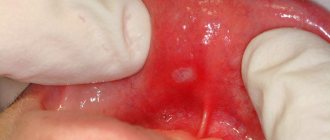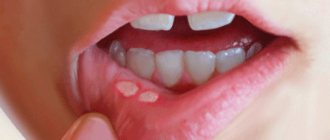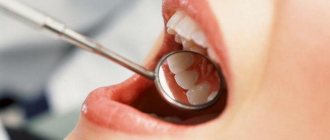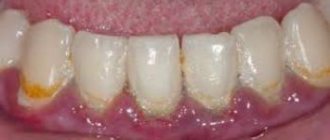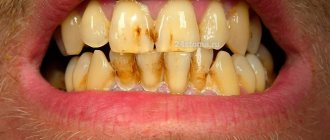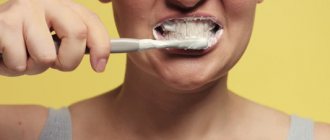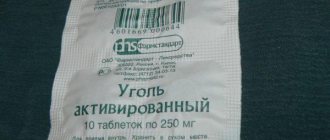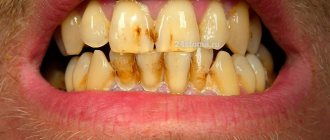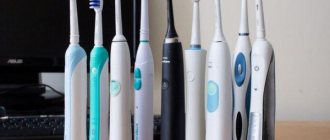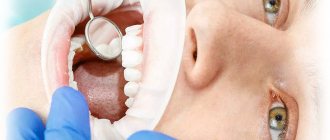Author of the article:
Soldatova Lyudmila Nikolaevna
Candidate of Medical Sciences, Professor of the Department of Clinical Dentistry of the St. Petersburg Medical and Social Institute, Chief Physician of the Alfa-Dent Dental Clinic, St. Petersburg
Everyone wants to have straight white teeth. A beautiful smile is not only a symbol of health. This is the key to self-confidence, one of the key factors in successful and fruitful communication. Is it worth mentioning that the white-toothed handsome man smiling at you in the reflection in the mirror every morning gives you an excellent mood for the whole day?
But what to do if plaque stubbornly appears on even teeth every morning? Can two cups of coffee during the day and a couple of packs of cigarettes put an end to a beautiful snow-white smile? Let's try to figure out why plaque appears on the teeth of adults, how to avoid it and how to deal with it.
Saliva and its role in oral health.
Firstly, saliva is a source of calcium and phosphorus for enamel (remember we talked about remineralization).
Secondly, saliva has a buffer capacity.
The buffering capacity of saliva is the ability to neutralize acids due to the interaction of the main buffer systems of saliva: bicarbonate and
phosphate
Eating carbohydrate foods for a long time reduces, and eating high-protein foods increases the buffer capacity of saliva.
On average, the pH of saliva in the oral cavity of a healthy person is between 6.5 and 7.5.
Slight fluctuations in pH are possible during the day and night (slightly lower at night).
An adult produces an average of 1500 to 2000 ml of saliva per day.
The rate of secretion depends very much on many factors - age, food irritant (I saw my favorite dish and even salivated, nervous excitement.
During sleep, saliva is secreted 8–10 times less.
The high buffering capacity of saliva is one of the most important factors that increases the resistance of teeth to caries.
The components of saliva make up the pellicle - a thin film that covers all surfaces of both hard and soft tissues of the oral cavity.
The pellicle has many tasks, including regulating the microbiota of the oral cavity.
The deposition of cells and food debris from saliva onto the pellicle leads to the formation of dental plaque - a loose white substance made of bacteria, desquamated epithelium, leukocytes and food debris.
The compaction of a pellicle in a certain place and the accumulation of bacteria there is a bacterial plaque, the source of caries.
Now, with an understanding of what saliva is needed for and what a pellicle is, let’s return to the topic of plaque.
Injury
Children's outdoor games are accompanied by injuries that do not immediately manifest themselves. When a tooth is bruised, the thin blood vessels entering through the root apex may rupture, forming a hematoma in the pulp chamber. The crown part of the tooth remains intact, but changes color. If a child’s tooth has darkened after a blow, it is imperative to see a dentist to treat the injury. Otherwise, inflammation of the baby tooth can affect the development of the permanent follicle, which is located deep in the bone.
Dental specialists will tell you what to do if a child’s tooth has darkened. To detect hidden problems and eliminate them in a timely manner, it is necessary to undergo regular preventive examinations with a dentist. Doctors at the Shifa clinic will teach the child the rules of hygienic care and select a toothbrush and toothpaste appropriate for his age. If you have darkened teeth, our specialists will create a personalized program for restoring dental aesthetics. The clinic has all the necessary equipment to make your child’s teeth beautiful and healthy.
Which leads to a change in the color of the enamel.
Sometimes the tooth is already growing with spots due to some internal reasons.
But more often spots appear due to staining of the enamel or pellicle from the outside.
A very well-known option is teeth staining while taking medications such as iron or de-nol, which is popular among gastroenterologists.
But often plaque appears without any obvious external influence.
The most famous option is Priestley's plaque or, as it is called in English literature, “black stain”.
Video of teeth cleaning with AirFlow system
Notice
: Undefined variable: post_id in
/home/c/ch75405/public_html/wp-content/themes/UltraSmile/single-item.php
on line
45 Notice
: Undefined variable: full in
/home/c/ch75405/public_html/wp-content /themes/UltraSmile/single-item.php
on line
46
Rate this article:
plaque
What is Priestley's plaque?
This plaque looks like black specks or lines of specks along the neck of the tooth. Plaque is quite tightly attached to the surface of the tooth and is difficult to clean with a regular brush.
It is usually found in children, although it can occur in adults.
There is no evidence that this plaque is somehow related to the pathology of the gastrointestinal tract.
This plaque is called bacterial, and for good reason: if you look at the plaque, it turns out that these are plaques created by a community of special bacteria, with a predominance of Actinomyces (Actinomyces naeslundii).
Black plaques have higher calcium and phosphate contents than uncolored plaques.
The black color is the result of the interaction of iron and copper ions (they are in our saliva) and hydrogen sulfide, which is released by plaque bacteria - the same actinomycetes.
Preventing the reappearance of black plaque on teeth
Prevention of plaque formation includes:
- Regular dental and oral care. For babies, their gums are cleaned using cotton pads and special silicone tips. When the baby turns two years old, he needs to be taught to properly brush his teeth with a brush and toothpaste, as well as to regularly rinse after meals.
- Balanced diet. Your child's diet should include fewer sugar-laden foods and more natural fruits and a variety of vegetables.
- Timely limitation of the use of pacifiers and bottles. Long-term use of these items leads to the appearance of malocclusion, the development of a certain dependence, and the formation of so-called “bottle caries.” If a child can do without a pacifier and bottle, they should be disposed of.
In addition, you should constantly monitor the state of the child’s immune system and support it with the help of vitamins, which have a beneficial effect on the health of the teeth and the whole body. If you follow these simple recommendations, your child will always delight his parents with his beautiful and healthy smile.
How common is Priestley's plaque?
According to various sources, from 2.4 to 18% of people experience this plaque.
Plaque is found equally often in boys and girls.
The dependence of the frequency of plaque on the nature of nutrition and the level of oral hygiene is not yet clear.
Taking iron supplements by a child or even his mother during pregnancy makes plaque more likely.
Several authors have proposed their classifications of black plaque according to severity.
Encouraging fact: When the dentist removes plaque, there is usually good, strong, healthy enamel underneath. Most scientists believe that the presence of Priestley plaque even reduces the risk of tooth decay.
Studies have shown that the saliva of children with Priestley's plaque typically has a higher concentration of calcium and a buffer capacity - that is, the ability to resist acidification. Perhaps this fact explains the lower risk of caries.
As I mentioned, bacterial plaque doesn’t just affect children.
The photo below is a real clinical case, and not the actor’s preparation for filming the new part of Mad Max.
The photo shows a 60-year-old man with no bad habits and good oral hygiene.
The cause of his plaque turned out to be the bacterium Prevotella melaninogenica .
This bacterium may be part of the normal oral flora, giving the distinctive black color to plaque, especially in children. The bacterium produces hydrogen sulfide, which interacts with iron found in saliva. The result is black staining of the teeth and tongue.
In this case, she chose the oral cavity of an adult man.
By the way, this man still managed to get rid of plaque with the help of dentists and regular dental hygiene.
What can plaque on teeth be confused with?
Areas of enamel may appear yellowish due to severe erosion and dentin showing through
And teeth can also be green...
Reasons why plaque accumulates on enamel
- The main reason is basic non-compliance with hygiene rules. In order to effectively remove plaque, it is necessary to brush your teeth in the morning and evening, and after eating (even if you ate liver or an apple), rinse your mouth with specially designed solutions,
Failure to comply with hygiene rules
Important!
In order to keep your teeth clean and healthy, it is enough to brush them twice a day: morning and evening. In this case, it is very important to select the right hygiene products, and the procedure itself should take at least 3-4 minutes. It is very important to thoroughly clean bottlenecks, as this is where plaque accumulates to a greater extent.
- change in the “work” of teeth. If you chew on only one side, then the other side, accordingly, does not receive the load. This affects not only the condition of the teeth and ligaments that hold them in their sockets, but also causes their enamel to quickly become covered with plaque. Such problems can be caused by the presence of a diseased tooth or malocclusion, as well as diseases of the oral mucosa,
- the use of toothpastes and brushes of dubious quality, or incorrectly selected ones (for example, soft ones, which are prescribed only for certain problems of the oral cavity and are completely unable to remove plaque),
- eating mostly soft foods. This is often why plaque appears on children’s teeth. After all, solid food helps to naturally cleanse teeth of deposits.
On a note!
Dentists advise eating as many solid vegetables and fruits as possible - such as apples, carrots, and fresh cabbage.
- diseases of the digestive or endocrine system can also lead to imbalance in the oral cavity.
Conclusion:
Typically, dental plaque has nothing to do with the pathology of the gastrointestinal tract.
I had separate observations that plaques (not like Priestley’s plaque in appearance) decreased in parallel with the treatment of reflux in children with specialized complaints, but global conclusions cannot be drawn from this.
If the dentist, when trying to clarify the cause of plaque that forms too quickly, reveals dyspeptic complaints and some suspicious symptoms (sour breath, thick coating on the tongue), a referral to a gastroenterologist seems quite logical.
5, total, today
Dental removal techniques
These can be both primitive options and high-tech procedures. The choice of intervention method depends on the following factors:
- the patient's well-being;
- clinical picture (thickness, structure and density of the layer);
- age category;
- localization of formations.
It is acceptable to use several types in combination. They will serve as a supplement and speed up getting a positive result.
Ultrasound for removing solid deposits
How to remove plaque from teeth, from interdental spaces and other hard-to-reach places? The ultrasound method comes to the rescue. The waves crush the hardened layer, and then the broken off particles are washed away with water.
This method is suitable for cleaning both internal and external surfaces, areas between crowns. The structure of the incisors, canines and molars does not suffer from this procedure, however, if the patient has increased sensitivity, or there were too many layers, some discomfort may be felt for several days after visiting the dental office.
Laser removal
The laser beam removes the old stone absolutely painlessly by evaporating water into it. The tooth surface remains intact and is not damaged, the condition of the gums improves due to their tone. An additional advantage of the technique is its disinfecting (antibacterial) effect. There is also a drawback that may seem significant to some, but may not matter to others - it is high cost.
Manual removal
A classic option that has been used for decades. Hard deposits are torn off or scraped out with special devices - curette hooks.
This method in itself is traumatic, especially if the hardened layer has penetrated deep into the subgingival space. However, in some cases, this processing option is the only acceptable one due to certain contraindications and restrictions.
The patient may experience pain or other discomfort. To alleviate the condition, the doctor pre-treats the mucous membranes with a gel or anesthetic spray.
Chemical method
How will you clean your teeth from plaque in this case? The procedure can be used independently or in combination with others. More often, dentists choose the second option, and after chemical treatment they use laser, ultrasound or mechanical cleaning.
The essence of this technique is to apply a special gel-like composition with active ingredients (hydrochloric acid, hydrogen peroxide, etc.) to the surface of the enamel. A reaction occurs as a result of which the deposits are softened and washed away with water or removed manually using special tools.
Gentle Air-Flow sandblasting
Air-Flo is a method that is optimal in the presence of soft layers and a thin bacterial film. This way you cannot get rid of the hard stone.
During the procedure, the units are treated with a mixture of water, air, and special abrasives in powder form. The composition is supplied under a certain pressure.
Based on the results of medical manipulations, the overgrown layer is easily removed, without affecting the structure of the incisors, canines and molars, even if they are milk teeth. Patients who have chosen this technique note an undeniable advantage - the shade of the enamel becomes several tones lighter than before.
How to remove plaque at home
The effectiveness of traditional methods depends on the thickness and density of the accumulated layer. If the deposits have appeared recently and are moderately soft, it is enough to clean them in the usual way using a brush.
When yellowish or dark pigmentation appears on the enamel, harder bristles and products with abrasives (Lacalut White, Rembrandt “Anti-tobacco and coffee”, etc.) come to the rescue. However, such compositions should be used only after consulting a dentist and with his approval. By scratching the enamel, you can significantly worsen the condition of your incisors, canines and molars, causing caries and more serious oral diseases.
The patient should simultaneously receive answers to two questions from the doctor:
- how to clean your teeth from plaque at home so that it is quick, painless, but effective;
- what mixtures and solutions to use for safe cleansing without negative consequences.
Many patients use improvised components that have been highly effective for many years. One of the most popular is activated carbon. The tablets are crushed with a spoon or mortar to obtain fine-grained particles that remove deposits and polish the surface. A damp brush is dipped into the resulting powder, after which standard cleaning is performed for several minutes. After using the drug, you should rinse your mouth thoroughly with water. To prevent increased sensitivity, this method cannot be used more than 2-3 times a week.
Baking soda is also often used. The procedure is exactly the same as in the previous case. In the same way, it is indicated to use industrial tooth powder.
Essential oils (lemon, tea tree) are also highly effective. This is the safest home option since there is no exposure to abrasives. There are several ways to use these compounds:
- add 4 drops of oily liquid to a glass of warm water, rinse your mouth after your usual regular brushing;
- drop onto the brush before cleansing without paste.
But do not rush to use advice without recommendations from a dentist.
What is tartar
Microbes settle on the enamel during food consumption and digestion and multiply under the influence of a moist, warm environment near the gums. If they are not removed within the next fifteen hours, the process of mineralization of these organisms will begin.
After seven days, mineralization becomes irreversible, and after six months, the “dead” microorganisms turn into natural stone, the shade of which varies from yellow to dark brown.
Thus, up to 30% of tartar consists of organic compounds, and the amount of inorganic components gradually increases from 70 to 90%.
Additional Information. It is necessary to understand that the composition is not constant and varies depending on the period of mineralization. The amount of organic matter decreases with each day of hardening.
Remember that after just a couple of days of lack of careful hygiene, the film forms a rough surface that attracts even more plaque.
In addition, the occurrence of gum inflammation is beneficial to the stone, since this increases the amount of periodontal fluid, which contains the necessary salts and proteins to increase the colony of microorganisms and further mineralization.
What to do if your child's baby teeth are brown
The scope and scope of therapeutic measures is determined only by the dentist after an examination. Usually this:
- correction of nutrition, introduction of foods rich in calcium into the diet, limiting the consumption of sweets and baked goods;
- training in oral hygiene rules;
- taking multivitamins;
- the use of rinsing solutions (these can be ready-made medications or self-prepared decoctions of chamomile, calendula, etc.);
- professional plaque removal;
- filling (if the volume of work is large, this procedure is sometimes performed under general anesthesia).
Modern pediatric dentistry allows you to painlessly and without unnecessary stress cope with the problem of brown baby teeth and prevent damage to an already permanent bite.
